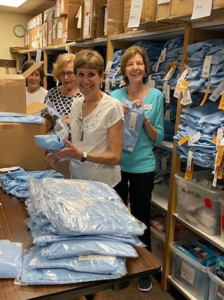How do volunteers provide children with shoes, when schools are closed & learning is virtual?
Mindy Hellmich, Assistance League of St. Louis member and Co-Chair of Steps to Success explains HOW: “You think outside the box. You think WAY outside the box!”
The all-volunteer Steps to Success (Steps) team has adapted and refined sizing, fitting and delivering children’s athletic shoes and socks since COVID began. They continue to streamline the system to provide shoes to children in St. Louis City and St. Louis County Schools. The program’s other Co-Chair is Beth Yeck. The Steps team focused on 25 schools in St. Louis City in the Winter-Spring 2020 session, using a voucher system. An Assistance League liaison provided each school with an envelope of vouchers for shoes and instructions in English and Spanish to be redeemed within 8 weeks at the Maplewood Shoe Carnival Store. The returns and redemption rate were disappointingly low. Results of a follow-up survey to parents revealed two issues: finding transportation and scheduling a fitting before the deadline. Undaunted, volunteers devised a new form for Spring 2021 to more accurately reflect the necessary requirements (child’s name, sizes/style). Parents’ responses and vouchers were then given to our Shoe Carnival contact, Katie Junge, who filled the orders at the Maplewood location. Chapter volunteer liaisons delivered over 1,900 athletic shoes and 3,300 pairs of socks safely to the schools.
OPERATION SCHOOL BELL®
 How do volunteers meet the challenge of providing fitted, new clothing when schools are closed? Claudia Dooley, Assistance League of St. Louis member and Co-Chair of Operation School Bell, reminisced about past years in which program volunteers took pride in being able to directly interact with the school children who visited our headquarters for uniform fittings and fun activities. Besides everyone being in high spirits, the team could take accurate measurements so that each child had fitted clothes that looked good. But that was the past, so the team leadership, also co-chaired by Kris Lewis, reviewed current processes, took what would work, dropped what didn’t and adapted so that they could continue fulfilling those objectives. The Operation School Bell team developed a process which included forms sent to school personnel; these were then passed along to parents who were responsible for measurements and noting any special needs. Schools would return the forms in batches via email. The forms were reviewed, fulfilled, bagged and delivered by chapter volunteer liaisons to the school for distribution.
How do volunteers meet the challenge of providing fitted, new clothing when schools are closed? Claudia Dooley, Assistance League of St. Louis member and Co-Chair of Operation School Bell, reminisced about past years in which program volunteers took pride in being able to directly interact with the school children who visited our headquarters for uniform fittings and fun activities. Besides everyone being in high spirits, the team could take accurate measurements so that each child had fitted clothes that looked good. But that was the past, so the team leadership, also co-chaired by Kris Lewis, reviewed current processes, took what would work, dropped what didn’t and adapted so that they could continue fulfilling those objectives. The Operation School Bell team developed a process which included forms sent to school personnel; these were then passed along to parents who were responsible for measurements and noting any special needs. Schools would return the forms in batches via email. The forms were reviewed, fulfilled, bagged and delivered by chapter volunteer liaisons to the school for distribution.
If you’ve ever measured someone for a sewing project or tailoring, you’ll appreciate the challenge that the Operation School Bell volunteers had when interpreting the responses. Claudia smiled and stated that the team was fortunate to have a number of ladies who “were really good fitters” and able to work out the appropriate sizes. Their success was realized when it was noted that very few of the packages were returned requesting a different size. The fitters hit the mark the majority of the time, even without being able to physically measure the children themselves.
Each package is generously filled with two pairs of pants, three polo shirts, one fleece jacket, six each of socks and underwear, a toothbrush, toothpaste, hat and gloves, a belt and a grade-appropriate new book. That’s a lot of items to pack when serving over 1,500 students and 28 elementary schools. But again, the team went into action and continued to refine processes and develop new ones for organizing and scheduling the packing days. Being mindful of COVID rules when organizing how many volunteers could be present on a packing day, remaining masked and staying socially distanced meant finely tuned logistical work had to be done upfront to hit their goal of completing packages in one day. That goal was met every time. Even under difficult circumstances, the team delivered over 28,000 items for students in 28 elementary schools and to stock closets in eight middle schools and 20 elementary schools. Closets are maintained to provide year-round clothing, shoes, coats and other necessities. In 2022, the program volunteers continue to take pride in their accomplishments knowing that COVID didn’t slow them down and hundreds of school children were warmly dressed this school season.
